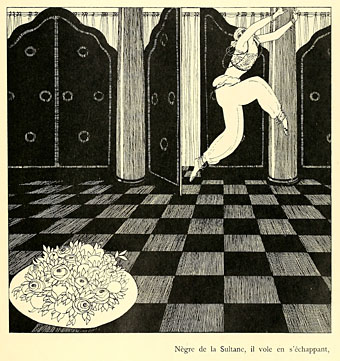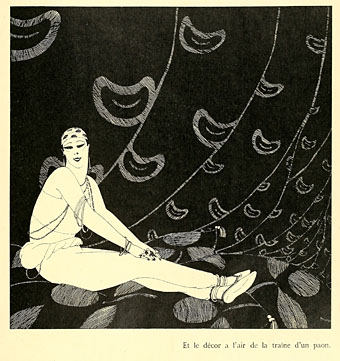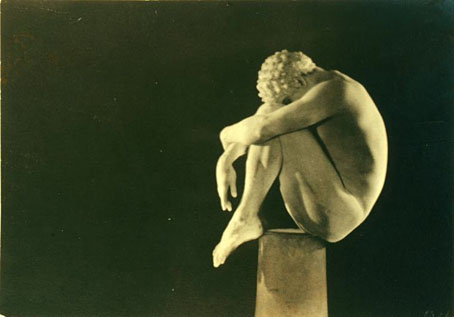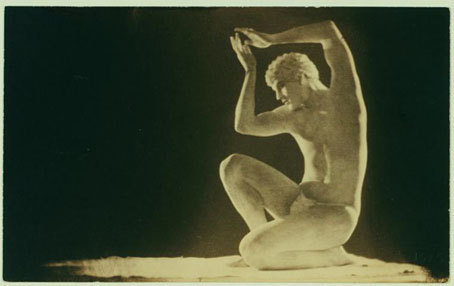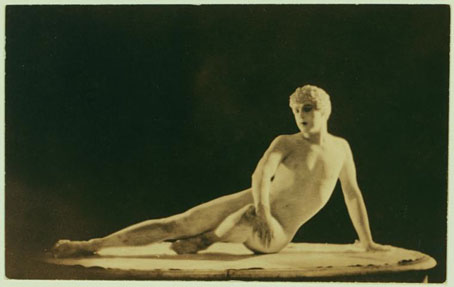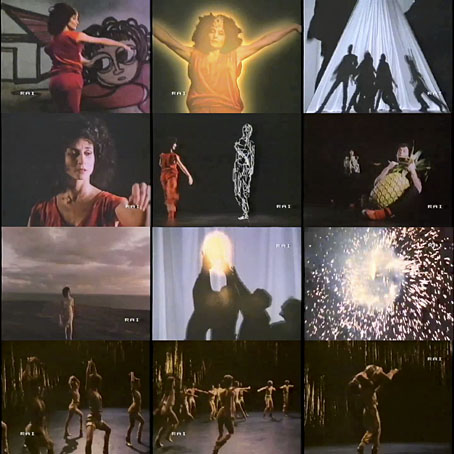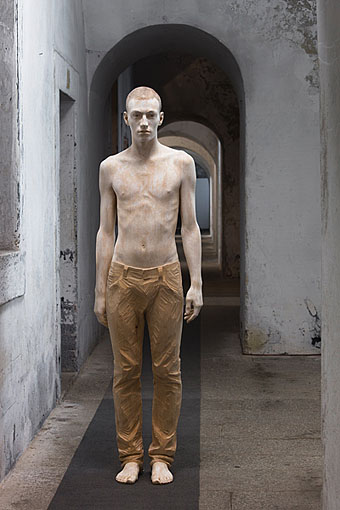Following some leads about American dancer Ted Shawn (1891–1972) turned up this series of photos from 1923 in which he adopts the Flandrin pose whilst enacting “The Death of Adonis”. The series is from a large collection of Shawn photos at the NYPL Digital Gallery. The dancer had dark hair which has here been covered by a light wig in order to convey a statue-like appearance. Poses plastiques, as they were known, were a common Victorian form of titillation which enabled variety audiences to admire near-naked women and men masquerading as living statuary or as figures from mythology and famous paintings. As with many Victorian fashions, they persisted into the early 20th century. Ted Shawn at this time was still married to dancer Ruth St Denis, and the pair had no qualms about displaying their bodies tastefully for the camera. Shawn is a fascinating figure so there’ll be a little more about him tomorrow.
Category: {dance}
Dance
The Catherine Wheel by Twyla Tharp
The music links this weekend were all related to my favourite Talking Heads period, 1979–1982, which not only encompasses the release of the band’s Fear Of Music and Remain In Light albums but also saw the individual group members produce some great solo records. I’d been playing one of these, the first Tom Tom Club album, all week while the sun was out. Now the temperature has dropped again, and we’re back to this summer’s default setting of perma-rain, the music doesn’t feel quite so appropriate. In 1981 while Tina Weymouth and Chris Frantz were exercising their funk muscles David Byrne was recording My Life In The Bush Of Ghosts with Brian Eno. The score Byrne produced immediately prior to this for the Twyla Tharp Dance Company often sounds like My Life… avant la lettre, with similar musicians (Eno included), sounds and rhythms. This is one reason I favour Songs From The Broadway Production Of “The Catherine Wheel” over Byrne’s subsequent solo albums.
The Catherine Wheel was a seventy-two minute dance film choreographed and directed by Twyla Tharp. The film was part-produced by the BBC and as far as I’m aware was only ever broadcast the once in Britain in 1983. Byrne’s score runs continuously as on the CD and cassette versions, the vinyl release being a re-sequenced editing of the tracks favouring the handful of songs. In dance terms the film was very innovative for the time, employing some subtle video effects and a couple of sequences where a duet is danced with a wire-frame CGI figure. A long end sequence, The Golden Section, predates The Catherine Wheel, and was apparently the origin of the project. Since I hadn’t seen any of this in nearly thirty years my search for Tom Tom Club videos at the weekend made me wonder whether YouTube had any Catherine Wheel clips, only to find that the entire film can be viewed here in a recording from Italian TV. (That copy was removed, link now goes to another one.) I’m so familiar with Byrne’s album it’s been fascinating seeing this again, especially since I only saw it on a small black-and-white TV originally and recalled very little of the performance. All the music works well enough on its own but seems completed when heard in this context, especially during The Golden Section. The film is also available on DVD from Kultur so this is another item for the shopping list.
Previously on { feuilleton }
• Moonlight in Glory
• My Life in the Bush of Ghosts
Green Pipes: Poems and Pictures
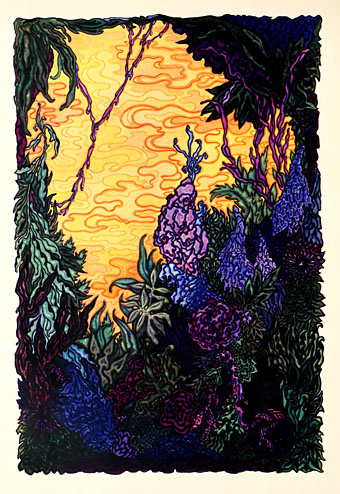
This is a strange book. Green Pipes: Poems and Pictures (1929) was written and illustrated by Joseph Rous Paget-Fredericks (1903–1963), a man better known these days for a substantial collection of memorabilia and archive material related to 20th-century dance. Paget-Fredericks studied with Léon Bakst then went on to create his own costume designs as well as producing some books for children of which this is an example. In style the poems aim at AA Milne’s When We Were Very Young but succumb to tweeness with a superfluity of fairies and pixies. At first glance the illustrations seem just as twee until you notice remarkable details such as costumes and foliage created from a wealth of disconnected lines and squiggles. The drawing of a Smoke Sprite is closer to something by Alastair than EH Shepard, while the Snow Fairy is the vaguest outline in a dress composed of circles, lines and dots. The Green Pipes of the title are the pipes of Pan, and so we get a late eruption of that peculiar flourishing of Pan Mania that extends from the 1890s to the 1930s. A book of children’s poetry isn’t the place you’d expect to encounter flower children kneeling before a piping faun but after the openly Pantheist chapter of The Wind in the Willows anything is possible. Far more out of place among all the fairies is a painting of a pirate brandishing a bloody cutlass. And what are we to make of the lines at the end of Elfin Children?
Then from the windowed heights we stream
By silent starlit mire…
The Starlit Mire (1911) was a book of epigrams by James Bertram & F. Russell illustrated by Austin Osman Spare (with a head of Pan blocked onto the cover). It’s not at all a book for children so the occurrence of that phrase in Paget-Fredericks’ poem is very surprising. Is “starlit mire” a quote that precedes the Bertram & Russell book? Please leave a comment if you know.
Read Green Pipes online here or download it here.
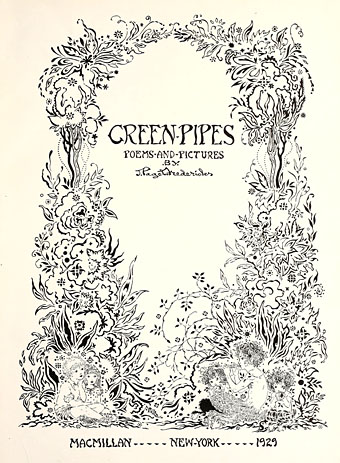
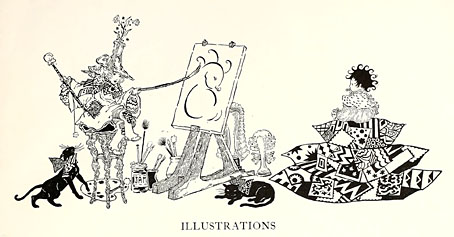
Weekend links 94
Mateo (2011), carved wood sculpture by Bruno Walpoth.
“Dennis Potter’s [The Singing Detective] is 25 years old but still feels avant garde,” says Stephen Armstrong. No fucking kidding, I watched the DVDs again last weekend. Potter’s drama featured non-linear flashbacks, song-and-dance hallucination sequences, an intertextual sub-plot, and a central character who was vitriolic, misanthropic, misogynist and covered from head-to-toe in flaking skin. This wasn’t exiled to an arts channel ghetto but was primetime viewing, Sunday evenings on BBC 1. • Related: “Is Dennis Potter’s singalong noir miniseries the all-time pinnacle of television drama? Graham Fuller thinks it is.”
• American band Earth are using Kickstarter to fund their next project, Wonders from the House of Albion, an LP/CD/DVD/book combining their music with “field recordings from various megalithic and other sites of human/fairy encounters across the UK, also the use of ritual and folkloric magical practices”. Dylan Carlson & Adrienne Davies discuss their work here.
…sort of like Nabokov’s objection to Our Lady of the Flowers, which he saw as a masterpiece but thought, “Why isn’t this book about women?” Nabokov hated homosexuality and was very edgy around it, partly because his own brother was homosexual and his uncle. And he believed that it was hereditary, so he was always nervous about it.
Edmund White chooses five favourite gay novels. Related: a dance adaptation by Earthfall of Jamie O’Neill’s At Swim, Two Boys.
• “The Belbury Tales is the kind of record you feel should have come out on Vertigo around ’73, but never actually did.” Belbury Poly‘s Jim Jupp on ploughman’s lunches, prog rock and avoiding “Clarkson/Wakeman territory”.
• Morbid Curiosity: The Richard Harris Collection, an exhibition at the Chicago Cultural Center exploring “the iconography of death across cultures and traditions spanning nearly six thousand years”.
• Geoff Dyer’s Zona, an exegesis of Andrei Tarkovsky’s Stalker, is officially out at the end of this month. The book is reviewed here and here.
• “Through a blurry electronic prism“: MetaFilter traces a history of analogue video synthesis.
• Dylan Ricci‘s wonderful photography of the male body has moved to a new location.
• Infinite Forest by Studio a+i, a design for an AIDS memorial in New York City.
• Susan Cain discussing “the power of introverts” at Scientific American.
• Strange Flowers on that icon of Middle Eastern music, Umm Kulthum.
• Ewan Morrison on “The self-epublishing bubble”.
• Winter Sleep (2007) by Valgeir Sigurdsson feat. Dawn McCarthy | Black (2008) by Ben Frost with Valgeir Sigurdsson, Sam Amidon & Sigrídur Sunna Reynisdóttir | Unbreakable Silence (2011) by Ben Frost & Daníel Bjarnason
Vaslav Nijinsky by Paul Iribe
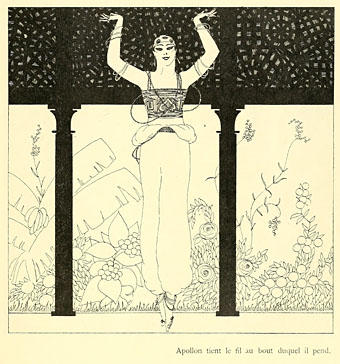
Another small and obscure volume hiding in the Internet Archive, Vaslav Nijinsky is a portfolio of six ink drawings by Paul Iribe (1883–1935) with a few lines of appended verse by Jean Cocteau. Iribe was a French designer and fashion illustrator who for a while was a member of the Ballets Russes circle, hence these depictions of the troupe’s most celebrated dancer. As post-Beardsley black-and-whites go these are pretty good although Iribe’s figures lack the requisite grace for their subject. If they were the only drawings of their kind that wouldn’t be so bad but one of Iribe’s contemporaries, George Barbier, produced his own superb series of Nijinsky drawings most of which can be seen here.
Note: the date given for this book at the Internet Archive is 1900 which seems quite wrong given that Nijinsky was still a young dancer in Russia at that time. Iribe’s drawings must date at least from 1910, maybe later.
